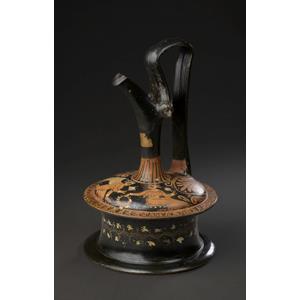IMAGE DETAILS

COLNAGHI
Attributed to the Menzies group
Red-figure epichysis in terracotta with Hermaphroditos and a woman
Greek, Apulian, circa 330-310 B.C.
H 21 cm
Provenance: Eugène Piot collection (1812-1890); his sale, 3 May 1870, lot n° 21; private collection, France; purchased from the above, 2022
Literature: F. Lenormand, Collection d’Antiquités Grecques recueillies dans la Grande-Grèce, l’Attique et l’Asie Mineure par M. Eug. P., Paris 1870, p. 16, n° 21
This epichysis is noteworthy for its provenance, as it was once part of the prestigious collection of Eugène Piot (1812–1890) - the French art critic, journalist, publisher, collector, and photographer - and it still bears his collection label. The present example also stands out for its above-average size and exceptional quality. It is in excellent condition and is typical of 4th-century BC Apulian Greek pottery.
This vessel, characterized by its elegant neck surmounting a coiled body, was probably used to contain precious liquids intended for sparing use. Its delicate mouth seems ill-suited for serving wine, as has sometimes been suggested in the past, with some even describing such vases as “low-shaped oinochoai with flat bottoms.” Rather, they were most likely used for oil or perfume. The dropper-like mouth is flanked by two small, stylized masks in relief.
The wide, disc-like shoulder of the vase has been decorated with particular attention to detail and form. The border is adorned with a frieze of eggs. A hermaphroditic Eros kneels and presents a mirror to a seated young woman, who also holds a mirror and a crown. On the reverse, an elegant arrangement of palmettes unfolds from the base of the handle and frames the central scene. The concave sides of the body are decorated with a vegetal frieze, overpainted in white and incised.
Comparable examples are held at the Getty Museum in Malibu and the Musée Saint-Raymond in Toulouse; both have been attributed to the Menzies Group, active during the third quarter of the 4th century BC.



 download image
download image